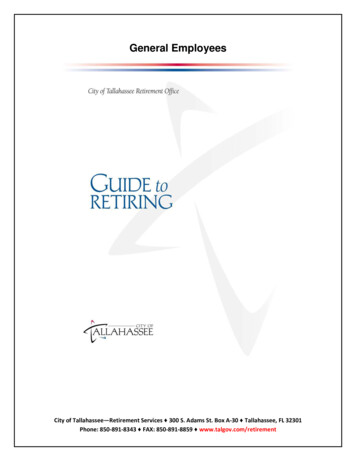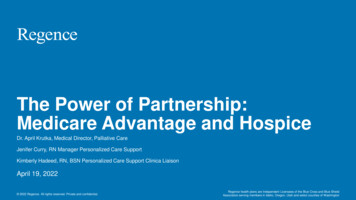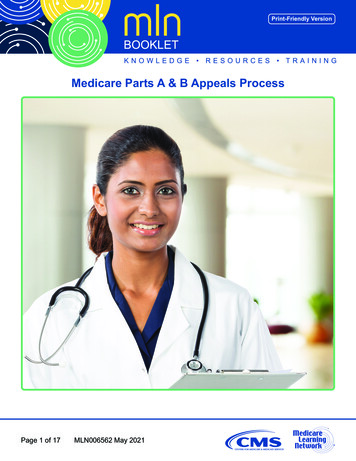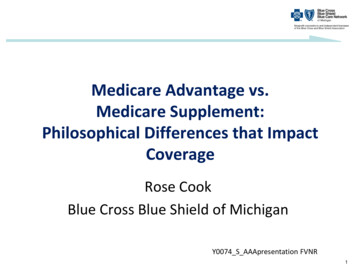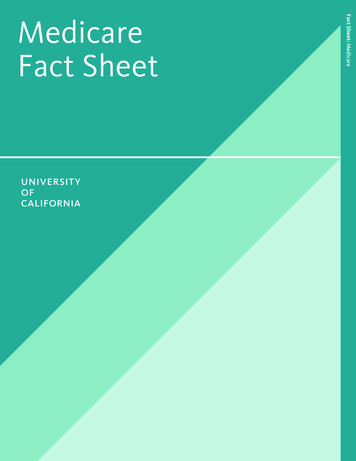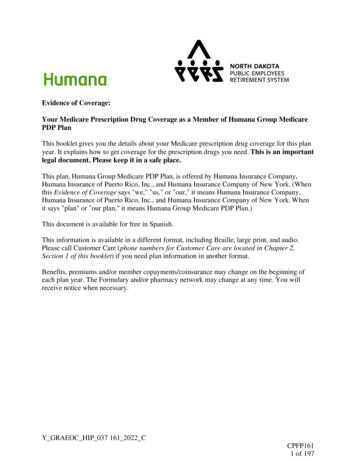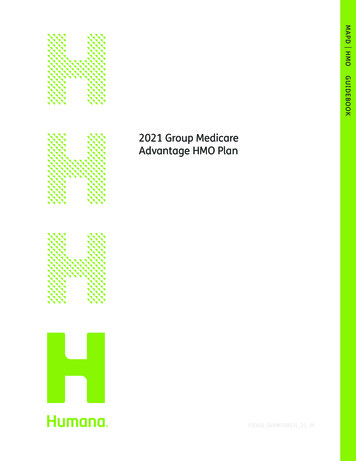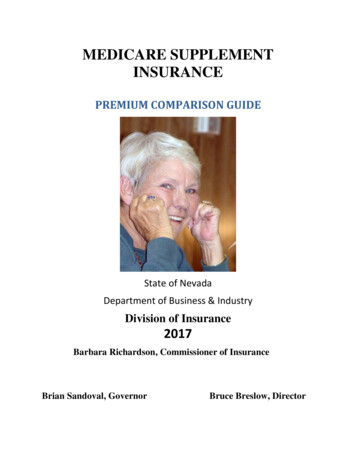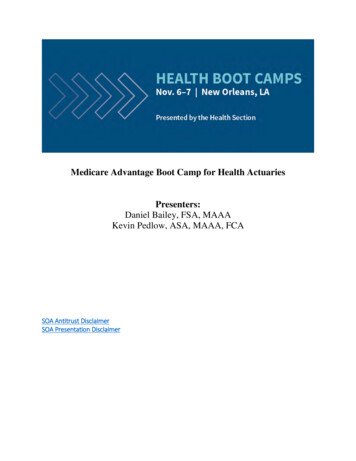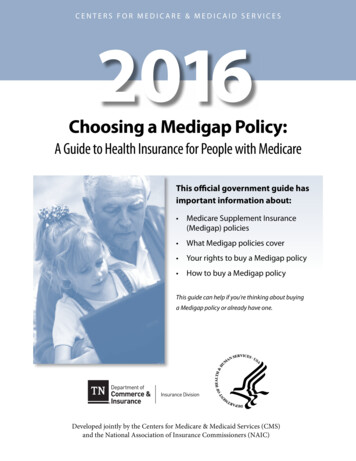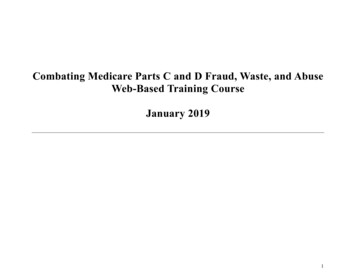
Transcription
Combating Medicare Parts C and D Fraud, Waste, and AbuseWeb-Based Training CourseJanuary 20191
Combating Medicare Parts C and D Fraud, Waste, and AbuseTABLE OF CONTENTSACRONYMS . 3TITLE . 4INTRODUCTION . 5LESSON 1: WHAT IS FWA? . 12LESSON 2: YOUR ROLE IN THE FIGHT AGAINST FWA . 32POST-ASSESSMENT. 55APPENDIX A: RESOURCES . 66APPENDIX B: JOB AIDS . 68Medicare Learning Network 2
Combating Medicare Parts C and D Fraud, Waste, and AbuseACRONYMSThe following acronyms are used throughout the course.Medicare Learning Network ACRONYMCFRDEFINITIONCode of Federal RegulationsCMSCenters for Medicare & Medicaid ServicesEPLSExcluded Parties List SystemFCAFalse Claims ActFDRsFirst-tier, Downstream, and Related EntitiesFWAFraud, Waste, and AbuseHIPAAHealth Insurance Portability and Accountability ActLEIEList of Excluded Individuals and EntitiesMAMedicare AdvantageMACMedicare Administrative ContractorMLNMedicare Learning Network NPINational Provider IdentifierOIGOffice of Inspector GeneralPBMPharmacy Benefits ManagerWBTWeb-Based Training3
Combating Medicare Parts C and D Fraud, Waste, and AbuseTITLETITLE PAGEMedicare Learning Network 4
Combating Medicare Parts C and D Fraud, Waste, and AbuseINTRODUCTIONINTRODUCTION PAGE 1The Combating Medicare Parts C and D Fraud, Waste, and Abusecourse is brought to you by the Medicare Learning Network Medicare Learning Network 5
Combating Medicare Parts C and D Fraud, Waste, and AbuseINTRODUCTION PAGE 2The Medicare Learning Network (MLN) offers free educational materials for health care professionals on the Centers for Medicare& Medicaid Services (CMS) programs, policies, and initiatives. Get quick access to the information you need. Publications & MultimediaEvents & TrainingNewsletters & Social MediaContinuing EducationHYPERLINK nuingEducation.htmlMedicare Learning Network LINKED TEXT/IMAGEPublications & MultimediaEvents & TrainingNewsletters & Social MediaContinuing Education6
Combating Medicare Parts C and D Fraud, Waste, and AbuseINTRODUCTION PAGE 3This training assists Medicare Parts C and D plan Sponsors’ employees, governing body members, and their first-tier, downstream,and related entities (FDRs) to satisfy their annual fraud, waste, and abuse (FWA) training requirements in the regulations and subregulatory guidance at: 42 Code of Federal Regulations (CFR) Section 422.503(b)(4)(vi)(C)42 CFR Section 423.504(b)(4)(vi)(C)CMS-4182-F, Medicare Program; Contract Year 2019 Policy and Technical Changes to the Medicare Advantage and theMedicare Prescription Drug Benefit ProgramsSection 50.3.2 of the Compliance Program Guidelines (Chapter 9 of the Medicare Prescription Drug Benefit Manual andChapter 21 of the Medicare Managed Care Manual)Sponsors and their FDRs are responsible for providing additional specialized or refresher training on issues posing FWA risks basedon the employee’s job function or business setting.HYPERLINK URLhttps://www.ecfr.gov/cgi-bin/textidx?SID c66a16ad53319afd0580db00f12c5572&mc true&node pt42.3.422&rgn div5#se42.3.422 1503https://www.ecfr.gov/cgibin/retrieveECFR?gp &SID c66a16ad53319afd0580db00f12c5572&mc true&r PART&n pt42.3.423#se42.3.423 c21.pdfMedicare Learning Network LINKED TEXT/IMAGE42 Code of Federal Regulations (CFR) Section 422.50342 CFR Section 423.504CMS-4182-F, Medicare Program; Contract Year 2019 Policy andTechnical Changes to the Medicare Advantage and the MedicarePrescription Drug Benefit ProgramsChapter 9 of the Medicare Prescription Drug Benefit ManualChapter 21 of the Medicare Managed Care Manual7
Combating Medicare Parts C and D Fraud, Waste, and AbuseINTRODUCTION PAGE 4Why Do I Need Training?Every year billions of dollars are improperly spent because of FWA. It affects everyone—including you. This training will help youdetect, correct, and prevent FWA. You are part of the solution.Combating FWA is everyone’s responsibility! As an individual who provides health or administrative services for Medicare enrollees,every action you take potentially affects Medicare enrollees, the Medicare Program, or the Medicare Trust Fund.Medicare Learning Network 8
Combating Medicare Parts C and D Fraud, Waste, and AbuseINTRODUCTION PAGE 5Training Requirements: Plan Employees, Governing Body Members, and First-Tier, Downstream, or RelatedEntity (FDR) EmployeesCertain training requirements apply to people involved in Medicare Parts C and D. All employees of Medicare AdvantageOrganizations (MAOs) and Prescription Drug Plans (PDPs) (collectively referred to in this course as “Sponsors”) must receivetraining for preventing, detecting, and correcting FWA.FWA training must occur within 90 days of initial hire and at least annually thereafter.More information on other Medicare Parts C and D compliance trainings and answers to common questions is available on the CMSwebsite.Learn more about Medicare Part CMedicare Part C, or Medicare Advantage (MA), is a health insurance option available to Medicare beneficiaries. Private,Medicare-approved insurance companies run MA programs. These companies arrange for, or directly provide, health careservices to the beneficiaries who enroll in an MA plan.Learn more about Medicare Part DMedicare Part D, the Prescription Drug Benefit, provides prescription drug coverage to Medicare beneficiaries enrolled in Part Aand/or Part B who enroll in a Medicare Prescription Drug Plan (PDP) or an MA Prescription Drug (MA-PD) plan. Medicareapproved insurance and other companies provide prescription drug coverage to individuals living in a plan’s service area.HYPERLINK ud-Waste Abuse-Training 12 13 11.pdfMedicare Learning Network LINKED TEXT/IMAGEMedicare Parts C and D compliance trainings and answers to commonquestions9
Combating Medicare Parts C and D Fraud, Waste, and AbuseINTRODUCTION PAGE 6Navigating and Completing This CourseAnyone providing health or administrative services to Medicare enrollees must satisfy generalcompliance and FWA training requirements. You may use this WBT course to satisfy the FWArequirements.Medicare Learning Network Visit the Resources page fordisclaimers, a glossary, andfrequently asked questions(FAQs). You may find thisinformation useful as youproceed through this course.10
Combating Medicare Parts C and D Fraud, Waste, and AbuseINTRODUCTION PAGE 8Course ObjectivesWhen you complete this course, you should correctly: Recognize FWA in the Medicare ProgramIdentify the major laws and regulations pertaining to FWARecognize potential consequences and penalties associated with violationsIdentify methods of preventing FWAIdentify how to report FWARecognize how to correct FWASelect the “MAIN MENU” button to return to the Main Menu. Then, select “Lesson 1: What Is FWA?”Medicare Learning Network 11
Combating Medicare Parts C and D Fraud, Waste, and AbuseLESSON 1: WHAT IS FWA?LESSON 1 PAGE 1Lesson 1: Introduction and Learning ObjectivesThis lesson describes fraud, waste, and abuse (FWA) and the laws that prohibit it. It should take about 10 minutes to complete. Uponcompleting the lesson, you should be able to correctly: Recognize FWA in the Medicare ProgramIdentify the major laws and regulations pertaining to FWARecognize potential consequences and penalties associated with violationsMedicare Learning Network 12
Combating Medicare Parts C and D Fraud, Waste, and AbuseLESSON 1 PAGE 2FraudFraud is knowingly and willfully executing, or attempting to execute, a schemeor artifice to defraud any health care benefit program or to obtain, by means offalse or fraudulent pretenses, representations, or promises, any of the money orproperty owned by, or under the custody or control of, any health care benefitprogram.In other words, fraud is intentionally submittingfalse information to the Government or aGovernment contractor to get money or a benefit.The Health Care Fraud Statute makes it a criminal offense to knowingly and willfully execute a scheme to defraud a health carebenefit program. Health care fraud is punishable by imprisonment up to 10 years. It is also subject to criminal fines up to 250,000.Medicare Learning Network 13
Combating Medicare Parts C and D Fraud, Waste, and AbuseLESSON 1 PAGE 3Waste and AbuseWaste includes practices that, directly or indirectly, result in unnecessary coststo the Medicare Program, such as overusing services. Waste is generally notconsidered to be caused by criminally negligent actions but rather by themisuse of resources.Abuse includes actions that may, directly or indirectly, result in unnecessarycosts to the Medicare Program. Abuse involves paying for items or serviceswhen there is no legal entitlement to that payment, and the provider has notknowingly or intentionally misrepresented facts to obtain payment.HYPERLINK ionDrugCovContra/Downloads/Chapter9.pdfMedicare Learning Network For the definitions of fraud, waste, and abuse,refer to Section 20, Chapter 21 of the MedicareManaged Care Manual and Chapter 9 of thePrescription Drug Benefit Manual on the Centersfor Medicare & Medicaid Services (CMS) website.LINKED TEXT/IMAGEChapter 21 of the Medicare Managed Care ManualChapter 9 of the Prescription Drug Benefit Manual14
Combating Medicare Parts C and D Fraud, Waste, and AbuseLESSON 1 PAGE 4Examples of FWAExamples of actions that may constitute Medicare fraud include: Knowingly billing for services not furnished or supplies not provided, including billing Medicare for appointments thepatient failed to keepBilling for nonexistent prescriptionsKnowingly altering claim forms, medical records, or receipts to receive a higher paymentExamples of actions that may constitute Medicare waste include: Conducting excessive office visits or writing excessive prescriptionsPrescribing more medications than necessary for treating a specific conditionOrdering excessive laboratory testsExamples of actions that may constitute Medicare abuse include: Unknowingly billing for unnecessary medical servicesUnknowingly billing for brand name drugs when generics are dispensedUnknowingly excessively charging for services or suppliesUnknowingly misusing codes on a claim, such as upcoding or unbundling codesMedicare Learning Network 15
Combating Medicare Parts C and D Fraud, Waste, and AbuseLESSON 1 PAGE 5Differences Among Fraud, Waste, and AbuseThere are differences among fraud, waste, and abuse. One of the primary differences is intent and knowledge. Fraud requires intentto obtain payment and the knowledge the actions are wrong. Waste and abuse may involve obtaining an improper payment orcreating an unnecessary cost to the Medicare Program but do not require the same intent and knowledge.Medicare Learning Network 16
Combating Medicare Parts C and D Fraud, Waste, and AbuseLESSON 1 PAGE 6Understanding FWATo detect FWA, you need to know the law.The following pages provide high-level information about the following laws: Civil False Claims Act, Health Care Fraud Statute, and Criminal FraudAnti-Kickback StatuteStark Statute (Physician Self-Referral Law)Exclusion from all Federal health care programsHealth Insurance Portability and Accountability Act (HIPAA)For details about specific laws, such as safe harbor provisions, consult the applicable statute and regulations.Medicare Learning Network 17
Combating Medicare Parts C and D Fraud, Waste, and AbuseLESSON 1 PAGE 7Civil False Claims Act (FCA)The civil provisions of the FCA make a person liable to pay damages to the Government if he or she knowingly:Conspires to violate the FCACarries out other acts to obtain property from the Government bymisrepresentationConceals or improperly avoids or decreases an obligation to pay theGovernmentMakes or uses a false record or statement supporting a false claimPresents a false claim for payment or approval Damages and PenaltiesAny person who knowingly submitsfalse claims to the Government isliable for three times the Government’sdamages caused by the violator plus apenalty.For more information, refer to 31 United States Code (USC) Sections 3729–3733.EXAMPLESA Medicare Part C plan in Florida: Hired an outside company to review medical records to find additional diagnosis codes it could submit toincrease risk capitation payments from CMSWas informed by the outside company that certain diagnosis codes previously submitted to Medicare wereundocumented or unsupportedFailed to report the unsupported diagnosis codes to MedicareAgreed to pay 22.6 million to settle FCA allegationsThe owner-operator of a medical clinic in California: Used marketers to recruit individuals for medically unnecessary office visitsPromised free, medically unnecessary equipment or free food to entice individualsCharged Medicare more than 1.7 million for the schemeWas sentenced to 37 months in prisonMedicare Learning Network 18
Combating Medicare Parts C and D Fraud, Waste, and AbuseHYPERLINK -subchapIII.pdfLINKED TEXT/IMAGE31 United States Code (USC) Sections 3729–3733LESSON 1 PAGE 8Civil FCA (continued)WhistleblowersA whistleblower is a person who exposes information or activity that is deemed illegal, dishonest, or violates professional or clinicalstandards.Protected: Persons who report false claims or bring legal actions to recover money paid on false claims are protected fromretaliation.Rewarded: Persons who bring a successful whistleblower lawsuit receive at least 15 percent, but not more than 30 percent, of themoney collected.Medicare Learning Network 19
Combating Medicare Parts C and D Fraud, Waste, and AbuseLESSON 1 PAGE 9Health Care Fraud StatuteThe Health Care Fraud Statute states, “Whoever knowingly and willfully executes, or attempts to execute, a scheme or artifice todefraud any health care benefit program shall be fined under this title or imprisoned not more than 10 years, or both.”Conviction under the statute does not require proof the violator had knowledge of the law or specific intent to violate the law. Formore information, refer to 18 USC Sections 1346–1347.EXAMPLESA Pennsylvania pharmacist: Submitted claims to a Medicare Part D plan for non-existent prescriptions and drugs not dispensedPleaded guilty to health care fraudReceived a 15-month prison sentence and was ordered to pay more than 166,000 in restitution to the planThe owner of multiple Durable Medical Equipment (DME) companies in New York: Falsely represented themselves as one of a nonprofit health maintenance organization’s (that administered aMedicare Advantage plan) authorized vendorsProvided no DME to any beneficiaries as claimedSubmitted almost 1 million in false claims to the nonprofit; 300,000 was paidPleaded guilty to one count of conspiracy to commit health care fraudHYPERLINK 346.pdfMedicare Learning Network LINKED TEXT/IMAGE18 USC Sections 1346–134720
Combating Medicare Parts C and D Fraud, Waste, and AbuseLESSON 1 PAGE 10Criminal Health Care FraudPersons who knowingly make a false claim may be subject to: Criminal fines up to 250,000Imprisonment for up to 20 yearsIf the violations resulted in death, the individual may be imprisoned for any term of years or for life.For more information, refer to 18 USC Section 1347.HYPERLINK 347.pdfMedicare Learning Network LINKED TEXT/IMAGE18 USC Section 134721
Combating Medicare Parts C and D Fraud, Waste, and AbuseLESSON 1 PAGE 11Anti-Kickback StatuteThe Anti-Kickback Statute prohibits knowingly and willfully soliciting,receiving, offering, or paying remuneration (including any kickback,bribe, or rebate) for referrals for services that are paid, in whole or inpart, under a Federal health care program (including the MedicareProgram).Damages and PenaltiesViolations are punishable by: A fine up to 25,000Imprisonment up to 5 yearsFor more information, refer to the Social Security Act (theAct), Section 1128B(b).For more information, refer to 42 USC Section 1320a-7b(b).EXAMPLEFrom 2012 through 2015, a physician operating a pain management practice in Rhode Island: Conspired to solicit and receive kickbacks for prescribing a highly addictive version of the opioid FentanylReported patients had breakthrough cancer pain to secure insurance paymentsReceived 188,000 in speaker fee kickbacks from the drug manufacturerAdmitted the kickback scheme cost Medicare and other payers more than 750,000The physician must pay more than 750,000 restitution and is awaiting sentencing.HYPERLINK rtA-sec1320a-7b.pdfhttps://www.ssa.gov/OP Home/ssact/title11/1128B.htmMedicare Learning Network LINKED TEXT/IMAGE42 USC Section 1320a-7b(b)Social Security Act (the Act), Section 1128B(b)22
Combating Medicare Parts C and D Fraud, Waste, and AbuseLESSON 1 PAGE 12Stark Statute (Physician Self-Referral Law)The Stark Statute prohibits a physician from making referrals forcertain designated health services to an entity when the physician (or amember of his or her family) has: An ownership/investment interest orA compensation arrangementExceptions may apply. For more information, refer to 42 USC Section1395nn.Damages and PenaltiesMedicare claims tainted by an arrangement that does notcomply with the Stark Statute are not payable. A penaltyof around 24,250 can be imposed for each serviceprovided. There may also be around a 161,000 fine forentering into an unlawful arrangement or scheme.For more information, visit the Physician Self-Referralwebpage and refer to the Act, Section 1877.EXAMPLEA California hospital was ordered to pay more than 3.2 million to settle Stark Law violations for maintaining 97 financialrelationships with physicians and physician groups outside the fair market value standards or that were improperly documentedas exceptions.HYPERLINK a.gov/OP Home/ssact/title18/1877.htmMedicare Learning Network LINKED TEXT/IMAGE42 USC Section 1395nnPhysician Self-Referral webpagethe Act, Section 187723
Combating Medicare Parts C and D Fraud, Waste, and AbuseLESSON 1 PAGE 13Civil Monetary Penalties (CMP) LawThe Office of Inspector General (OIG) may impose civil penalties for several reasons, including: Arranging for services or items from an excluded individualor entityProviding services or items while excludedFailing to grant OIG timely access to recordsKnowing of and failing to report and return an overpaymentMaking false claimsPaying to influence referralsFor more information, refer to 42 USC 1320a-7a and the Act, Section1128A(a).Damages and PenaltiesThe penalties can be around 15,000 to 70,000depending on the specific violation. Violators are alsosubject to three times the amount: Claimed for each service or item orOf remuneration offered, paid, solicited, orreceivedEXAMPLEA California pharmacy and its owner agreed to pay over 1.3 million to settle allegations they submitted unsubstantiated claimsto Medicare Part D for brand name prescription drugs the pharmacy could not have dispensed based on inventory records.HYPERLINK artAsec1320a-7a.pdfLINKED TEXT/IMAGE42 USC 1320a-7ahttps://www.ssa.gov/OP Home/ssact/title11/1128A.htmthe Act, Section 1128A(a)Medicare Learning Network 24
Combating Medicare Parts C and D Fraud, Waste, and AbuseLESSON 1 PAGE 14ExclusionNo Federal health care program payment may be made for any item or service furnished, ordered, or prescribed by an individual orentity excluded by the OIG. The OIG has authority to exclude individuals and entities from federally funded health care programs andmaintains the List of Excluded Individuals and Entities (LEIE).The U.S. General Services Administration (GSA) administers the Excluded Parties List System (EPLS), which contains debarmentactions taken by various Federal agencies, including the OIG. You may access the EPLS on the System for Award Management(SAM) website.When looking for excluded individuals or entities, check both the LEIE and the EPLS since the lists are not the same. For moreinformation, refer to 42 USC Section 1320a-7 and 42 Code of Federal Regulations (CFR) Section 1001.1901.EXAMPLEA pharmaceutical company pleaded guilty to two felony counts of criminal fraud related to failure to file requiredreports with the U.S. Food and Drug Administration concerning oversized morphine sulfate tablets. Thepharmaceutical firm executive was excluded based on the company’s guilty plea. At the time the unconvictedexecutive was excluded, there was evidence he was involved in misconduct leading to the company’s conviction.HYPERLINK -sec10011901.pdfMedicare Learning Network LINKED TEXT/IMAGELEIEEPLS42 USC Section 1320a-742 Code of Federal Regulations (CFR)Section 1001.190125
Combating Medicare Parts C and D Fraud, Waste, and AbuseLESSON 1 PAGE 15Health Insurance Portability and Accountability Act (HIPAA)HIPAA created greater access to health care insurance, strengthened the protection of privacy of health care data, and promotedstandardization and efficiency in the health care industry.HIPAA safeguards deter unauthorized access to protected health careinformation. As an individual with access to protected health careinformation, you must comply with HIPAA.For more information, visit the HIPAA webpage.Damages and PenaltiesViolations may result in Civil Monetary Penalties. In somecases, criminal penalties may apply.EXAMPLEA former hospital employee pleaded guilty to criminal HIPAA charges after obtaining protected health information with the intentto use it for personal gain. He was sentenced to 12 months and 1 day in prison.HYPERLINK URLhttps://www.hhs.gov/hipaaMedicare Learning Network LINKED TEXT/IMAGEHIPAA webpage26
Combating Medicare Parts C and D Fraud, Waste, and AbuseLESSON 1 PAGE 16Lesson 1 SummaryThere are differences among fraud, waste, and abuse (FWA). One of the primary differences is intent and knowledge. Fraudrequires the person have intent to obtain payment and the knowledge his or her actions are wrong. Waste and abuse may involveobtaining an improper payment but not the same intent and knowledge.Laws and regulations exist that prohibit FWA. Penalties for violating these laws may include: Civil Monetary PenaltiesCivil prosecutionCriminal conviction, fines, or bothExclusion from all Federal health care program participationImprisonmentLoss of professional licenseMedicare Learning Network 27
Combating Medicare Parts C and D Fraud, Waste, and AbuseLESSON 1 PAGE 17Lesson 1 ReviewNow that you completed Lesson 1, let’s do a quick knowledge check. Your Post-Assessment score is unaffected by the followingquestions.Medicare Learning Network 28
Combating Medicare Parts C and D Fraud, Waste, and AbuseLESSON 1 PAGE 18Knowledge CheckSelect the correct answer.Which of the following requires intent to obtain payment and the knowledge the actions are wrong? A. Fraud B. Abuse C. WasteCORRECTANSWERAMedicare Learning Network 29
Combating Medicare Parts C and D Fraud, Waste, and AbuseLESSON 1 PAGE 19Knowledge CheckSelect the correct answer.Which of the following is NOT potentially a penalty for violation of a law or regulation prohibiting fraud, waste, and abuse (FWA)? A. Civil Monetary Penalties B. Deportation C. Exclusion from participation in all Federal health care programsCORRECTANSWERBMedicare Learning Network 30
Combating Medicare Parts C and D Fraud, Waste, and AbuseLESSON 1 PAGE 20You completed Lesson 1: What Is FWA?Now that you have learned about FWA and the laws and regulations prohibiting it, let’s look closer at your role in the fight againstFWA.Select the “MAIN MENU” button to return to the course Main Menu. Then, select “Lesson 2: Your Role in the Fight Against FWA” tobegin Lesson 2.Medicare Learning Network 31
Combating Medicare Parts C and D Fraud, Waste, and AbuseLESSON 2: YOUR ROLE IN THE FIGHT AGAINST FWALESSON 2 PAGE 1Lesson 2: Introduction and Learning ObjectivesThis lesson explains the role you can play in fighting against fraud, waste, and abuse (FWA), including your responsibilities forpreventing, reporting, and correcting FWA. It should take about 10 minutes to complete. Upon completing the lesson, you shouldcorrectly: Identify methods of preventing FWAIdentify how to report FWARecognize how to correct FWAMedicare Learning Network 32
Combating Medicare Parts C and D Fraud, Waste, and AbuseLESSON 2 PAGE 2Where Do I Fit In?As a person providing health or administrative services to a Medicare Part C or Part D enrollee, you are likely an employee of a: Sponsor (Medicare Advantage Organization [MAO] or a Prescription Drug Plan [PDP])First-tier entity (Examples: Pharmacy Benefit Management [PBM]; hospital or health care facility; provider group; doctor’soffice; clinical laboratory; customer service provider; claims processing and adjudication company; a company thathandles enrollment, disenrollment, and membership functions; and contracted sales agents)Downstream entity (Examples: pharmacies, doctor’s office, firms providing agent/broker services, marketing firms, andcall centers)Related entity (Examples: Entity with common ownership or control of a Sponsor, health promotion provider, orSilverSneakers )Medicare Learning Network 33
Combating Medicare Parts C and D Fraud, Waste, and AbuseLESSON 2 PAGE 3Where Do I Fit In? (continued)I am an employee of a Part C Plan Sponsor or an employee of a Part C Plan Sponsor’s first-tier or downstream entity.The Part C Plan Sponsor is a CMS Contractor. Part C Plan Sponsors may enter into contracts with FDRs. This stakeholderrelationship flow chart shows examples of functions relating to the Sponsor’s Medicare Part C contracts. First-tier and related entitiesof the Medicare Part C Plan Sponsor may contract with downstream entities to fulfill their contractual obligations to the Sponsor.Examples of first-tier entities may be independent practices, call centers, health services/hospital groups, fulfillment vendors, fieldmarketing organizations, and credentialing organizations. If the first-tier entity is an independent practice, then a provider could be adownstream entity. If the first-tier entity is a health service/hospital group, then radiology, hospital, or mental health facilities may bethe downstream entity. If the first-tier entity is a field marketing organization, then agents may be the downstream entity. Downstreamentities may contract with other downstream entities. Hospitals and mental health facilities may contract with providers.I am an employee of a Part D Plan Sponsor or an employee of a Part D Plan Sponsor’s first-tier or downstream entity.The Part D Plan Sponsor is a CMS Contractor. Part D Plan Sponsors may enter into contracts with FDRs. This stakeholderrelationship flow chart shows examples of functions that relate to the Sponsor’s Medicare Part D contracts. First-tier and relatedentities of the Part D Plan Sponsor may contract with downstream entities to fulfill their contractual obligations to the Sponsor.Examples of first-tier entities include call centers, PBMs, and field marketing organizations. If the first-tier entity is a PBM, then thepharmacy, marketing firm, quality assurance firm, and claims processing firm could be downstream entities. If the first-tier entity is afield marketing organization, then agents could be a downstream entity.Medicare Learning Netwo
Web-Based Training Course January 2019 . Combating Medicare Parts C and D Fraud, Waste, and Abuse . Medicare Learning Network 2 . . approved insurance and other companies provide prescription drug coverage to individuals living in a plan's service area. HYPERLINK URL LINKED TEXT/IMAGE .
